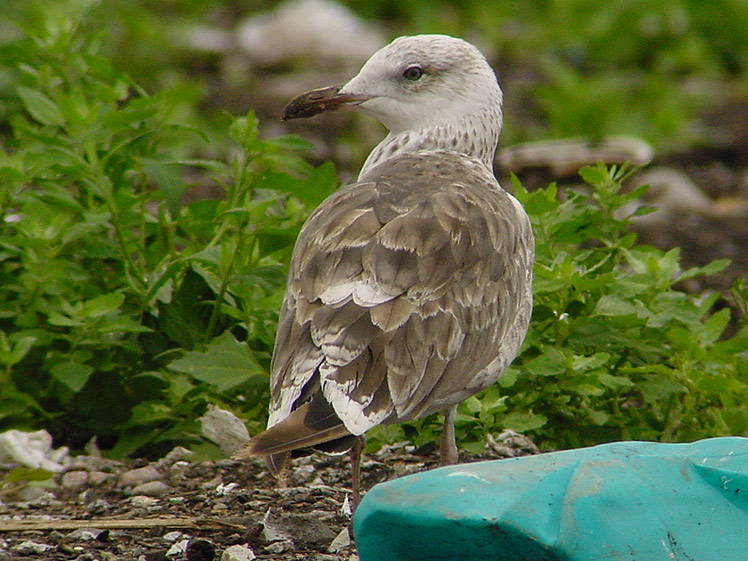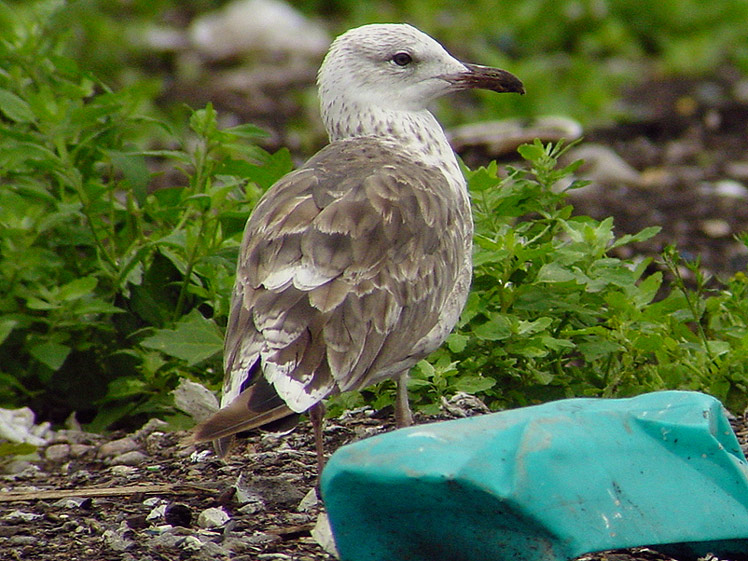(2 images) Larus fuscus fuscus (?) 2cy, July 13 2003, Tampere, Finland (61.33N 24.59E).

A rather pale brown 2cy bird with a few outer primaries left juvenile. It's hard to tell if primary moult was suspended prior to migration, or whether primary moult commenced in Scandinavia. Given that the vanguard of 2cy fuscus arrive in the first week of June, the last option seems to be odd. 2cy fuscus often replace primaries in the post-juvenile moult on the wintering ground, and may arrest this moult to migrate north. In this individual P1-P6 are second generation and P9-P10 are still juvenile. All tail-feathers are fresh second generation, probably replaced on the wintering ground.
Some new feathers grow in in the upper scapulars and in the rear lowest scapulars; they show a dark centre and a sub-terminal band on a grey-brown base. In the old bleached second generation scapulars this sub-terminal band is worn away.
The complete wing-covert panel has been replaced on the wintering ground (although some feathers in the carpal edge may still be juvenile), now second generation feathers, most with a similar pattern as the old second generation scapulars. This bird started another moult wave in the coverts and new feathers are visible in tertials and coverts: the upper two tertials are replaced, the second greater covert, some inner median coverts and central lower lesser coverts are replaced as well, showing a similar pattern as the fresh lower scapular. The bare part coloration is still most immature with a dark iris, slightly paler based bill and yellowish pink legs.
Moult score slightly advanced compared to average intermedius/graellsii in July in NW Europe (see July section), but see e.g. this advanced LBBG in the Netherlands, with P6 fully grown and P7 growing.
Typical Finnish fuscus in July have replaced primaries, rectrices and secondaries, all moulted in a complete post-juvenile moult on the wintering grounds, prior to northbound migration. The new second generation primaries are only a couple of months old and still look dark blackish. The second generation tail-feathers normally still show the white tips, but in some individuals these tips are worn away when 2cy birds arrive back in Scandinavia. Immediately after returning in Scandinavia some 2cy fuscus start a new moult cycle in the inner primaries, now growing in third generation feathers.
The complete moult in the winter quarters normally start with replacement of the scapulars and mantle-feathers in November to January, but the post-juvenile moult may already start in juvenile birds which are still in Scandinavia in September. The new scapulars often show a simple pattern of a black shaft-streak on a dark brown base. When most of the scapulars are replaced, fuscus start to replace the wing-coverts, in the ordinary sequence that can also be found in other gull taxa in Europe. Wing-covert moult is initiated in two loci, one wave starts in the outermost coverts, one wave starts in the innermost coverts. The two waves normally meet at covert #7-8. Normally the median covert row is the first row which is moulted, followed by the lower lesser coverts, the greater coverts and moult finishes in the outer lesser coverts (the carpal edge). If for whatever reason, moult in the wing-coverts is arrested, this is normally most obvious in the carpal edge and outer greater coverts, containing juvenile feathers which contrast with the other fresh coverts.
In classical 2cy fuscus, all wing-coverts are replaced to second generation on the wintering grounds, and by mid July in Scandinavia, a next moult wave is initiated, often including the median and lower lesser coverts, the inner greater coverts, upper tertials and scapulars. Bare part coloration may be very immature, including a black bill, but may also be very mature, with a yellow base and a red gonydeal spot on the lower mandible. Still, these birds are only 12 months old.

|
 nominate Lesser Black-backed Gull (L. fuscus)
nominate Lesser Black-backed Gull (L. fuscus)
